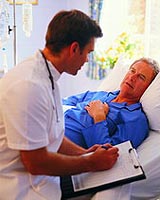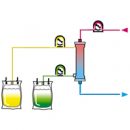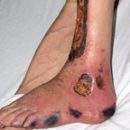So, the doctor has diagnosed you «Nephroptosis» And recommends the operation. Nothing can be done - we will have to operate, but how this operation will be made to choose you can already. The features of modern nephropsychia will tell a urologist.
Content

So, the competent doctor put this diagnosis and offered an operation - «Bearing» kidneys - nephropsychia, probably offering several options. What not suggested? And you ask - what way? Most likely it will be a traditional band-up operation on a side of 10 cm, using as a fixing material, for example, the muscular flap - everything is correct, it is so in the last century, we (practicing urologists) came, and, I must say, for the most part we continue work on this technique today. What requirements we place before the operation today?
- Kidney must be securely fixed.
- Restored normal kidney bleed and urine outflow.
- Renal tissue should not be injured during surgery.
- Kidney must preserve physiological mobility.
- Disability to restore should appear shortly after the operation.
All aspects are observed, but at what price: a long stay in bed, long healing of the postoperative wound, the probability of postoperative hernia, cosmetic defect of the lumbar region (coarse scar), long period of rehabilitation (21 days of strict beddown and restriction of physical activity within 6 months after surgery ). The question is naturally arising - and is there an alternative? Today we can already say that there is an alternative - this is an endovideosurgical (laparoscopic or lumboscopic) operation.
What it is? With the help of a special tool, modern surgical equipment, in the presence of certain surgeon skills, an operation is performed that allows you to perform nephropsychias («Bearing» kidney) in compliance with all the requirements listed earlier using all the former, t.e as for open operations, techniques and techniques. The difference in access and technique to reduce the traumatic operation.
Another one, in our opinion, the advantage - during a laparoscopic operation, the possibility of identifying the pathology of the organs, clinically earlier itself in any way and its elimination, for example - adhesive disease - spikes can be successfully disconnected.
- Need special equipment and tools.
- Separate operational.
- Personnel trained for laparoscopic operations.
- The presence of consumables.
But if there is equipment, operating, specially trained personnel, and the patient is ensured by consumables - there are no shortcomings. Thus, these are relative disadvantages.
- Long stay in bed.
- Healing postoperative wound.
- Possibility of the development of postoperative hernia.
- Cosmetic lumbar defect.
- Long term rehabilitation.
As can be seen, due to the emergence of modern equipment and new techniques, endovoscopy firmly occupied its, rightfully worthy of place in the treatment of pathological kidney mobility.
1st operation is made by the traditional method. The postoperative period amounted to 11 days, the term of complete rehabilitation 3 months.
After a year, a laparoscopic nephropsychia, a laparoscopic nephropsychia, a rating grid on the other side - the postoperative period - 3 days, the period of complete rehabilitation 1 month + cosmetic effect.
So draw conclusions and choices.









